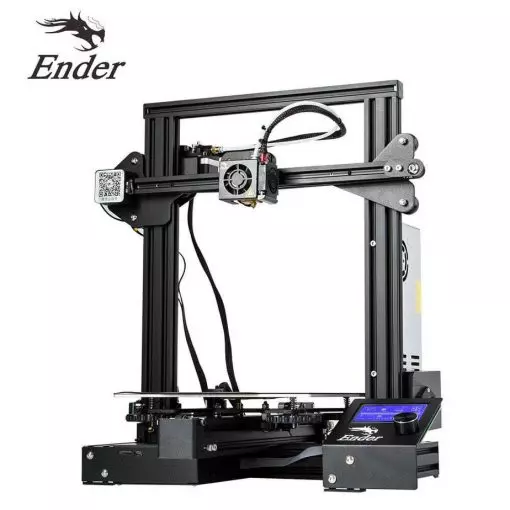Compare Ender 3 vs H2D
Comparison between the best 3D printers
Choose the best 3D printer at the best price. The cheapest 3D printers are here.
Buy a 3D printer here with 3D Fila.
 |
 |
|
| Model | Ender 3[BUY Ender 3] |
H2D |
| Printing Material | Filament | Filament |
| Buy Filament for Creality 3D Ender 3 | Buy Filament forBambu Lab H2D | |
| Estimated price | $210,00 | $1899,00 |
| Manufacturer | Creality 3D | Bambu Lab |
| Release Year | 2018 | 2025 |
| Print Volume [mm] | 220x220x250 | 350x320x325 |
| Printer Size [mm] | 440x440x465 | 492x514x626 |
| Weight [kg] | 6,62 | 42,3 |
| Power Loss Recovery | NO | YES |
| Enclosed printer | NO | YES |
| Bed Leveling | Manual | Automatic |
| Filament End Sensor | NO | YES |
| Bed type | Heated | Heated |
| Power supply system | Bowden | Direct Drive |
| Standard nozzle | 0,4 | 0,4 |
| Maximum Nozzle Temperature [°C] | 255 | 350 |
| Maximum Bed Temperature [°C] | 110 | 120 |
| Maximum printing speed [mm/s] | 180 | 600 |
| Filament holder | YES | YES |
| Camera for supervision | NO | NO |
| Recommended filaments | PLA, TPU, ABS, PETG | PLA, PETG, ABS, ASA, TPU, PVA, Nylon (PA) |
| Recommended slicers | Cura, Simplify, Slic3r | Bambu Studio |
| Maximum Resolution [mm] | 0,1 | 0,01 |
| Processor | 8 bits | |
| Display | Mono | Touchscreen 5'' |
| Power Supply | 24V / 270W | |
| Connectivity | SD / USB | Wifi, Bambu bus, Cartão SD |
| Operating systems | Windows, Mac, Linux | Windows, Mac, Linux |
| Date of registration in the system | 2021-04-13 | 2025-03-31 |
| Release date | 2018 | 2025 |
| Extra features | The Ender 3 V1 is a DIY assembly 3D printer, a sales leader since 2017, standing out for its cost-benefit. With a wide printing capacity, it has a CNC machined structure for precision and stability. It offers high-precision prints with low noise, thanks to its innovative V-profile and pulleys. It has a self-adhesive magnetic platform for easy removal of models and excellent adhesion. The Ender 3 heats up quickly, reaching 100°C in 5 minutes, ideal for agile prints. It includes protection against power failures, allowing you to resume printing after interruptions, saving time and material. | Bambu Labs H2D combines high-speed 3D printing with a chamber heated up to 65 °C, dual extrusion with automatic nozzle switching, an AMS for filament drying and exchange, and AI sensors that detect failures. It offers optional laser and digital cutting capabilities, features intelligent calibration through computer vision, vibration control, enhanced fire safety, and real-time camera monitoring. |
| Support for multiple colors and materials (AMS and CFS) | NO | YES |
Notes * |
||
| Cost-benefit | 6 / 10 | 7 / 10 |
| Hardware | 0.5 / 10 | 7.2 / 10 |
| Tela | . | . |
| Print volume | 3 / 10 | 4 / 10 |
| Performance | 1 / 10 | 5 / 10 |
| [BUY Ender 3] |
Conclusion |
| In comparing the Ender 3 and the Bambu Lab H2D, the two 3D printers clearly serve different user bases and needs in the 3D printing market. The Ender 3, a budget-friendly option released in 2018, is a well-regarded choice for hobbyists and those new to 3D printing. Its affordability, decent print volume, and solid performance for basic tasks make it an attractive option for beginners or those seeking a cost-effective solution. However, it lacks advanced features such as automatic bed leveling and power loss recovery, which can limit usability and convenience, particularly for users who may not have the technical skills or confidence for manual adjustments. In contrast, the Bambu Lab H2D, introduced in 2025, presents a feature-rich and high-performance alternative designed for more serious users and professionals. Its larger print volume, faster maximum printing speed, and automated features—like bed leveling and filament sensors—enhance its usability and make it better suited for complex projects. Furthermore, the H2D’s more advanced capabilities, such as dual extrusion, intelligent calibration, and onboard monitoring, significantly elevate its value for those looking to push the boundaries of what is possible with 3D printing. While the Ender 3 offers a strong cost-benefit ratio, especially for newcomers to the field, the H2D caters to those who require more advanced features and performance. Users must weigh their specific needs against budget considerations—whether to invest in a more economical yet limited model or to opt for a premium printer with extensive capabilities. Ultimately, the choice depends on the user's experience level, printing ambitions, and budget constraints. |

